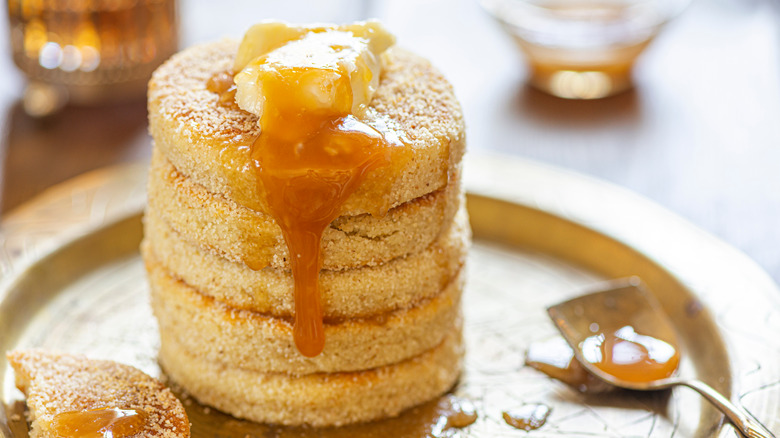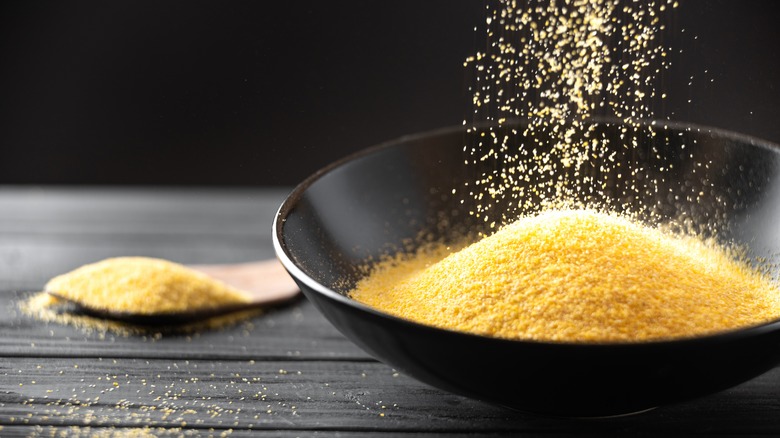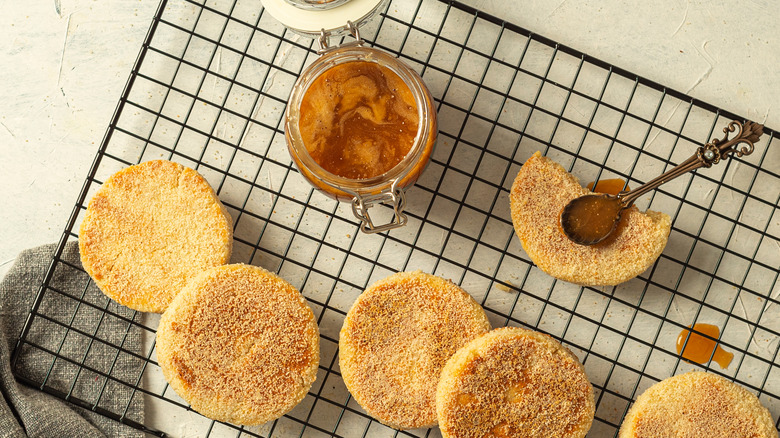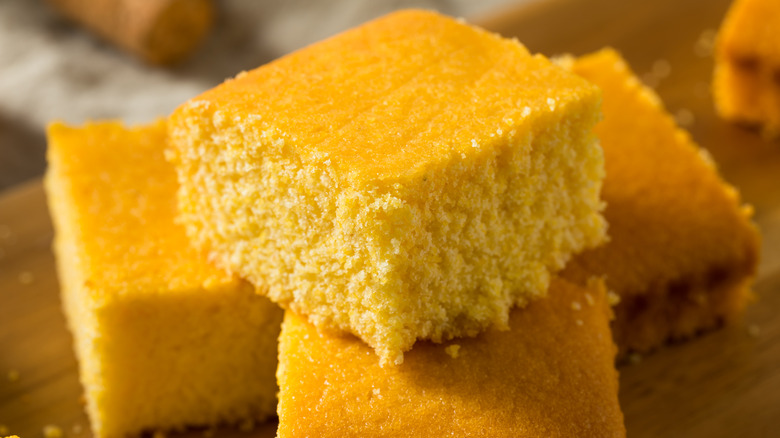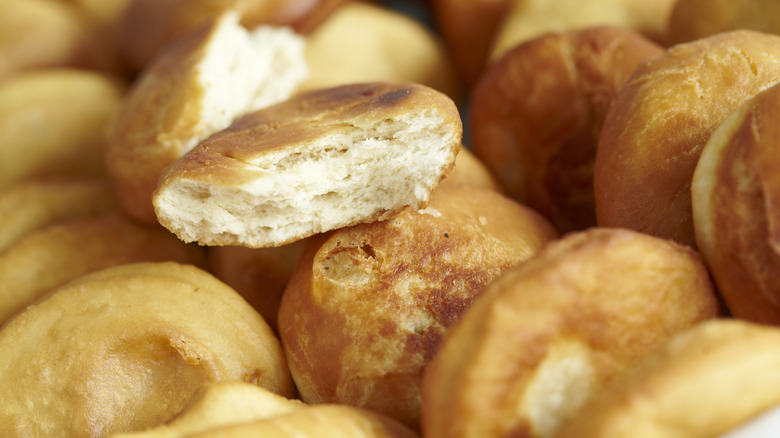Fried Cornbread Is A Southern Comfort Breakfast Worth Craving
You've probably enjoyed cornbread in one form or another, but if you've never experienced fried cornbread — also known as johnnycakes or hot water cornbread — you are missing out on a delicious treat. Fried cornbread isn't baked like you may be accustomed to, but cooked in oil on a griddle, sort of like an American answer to England's crumpet. Their origins go back long ago to early indigenous Americans, who cultivated corn crops that were eventually ground down into corn meal, the main ingredient of fried cornbread, but remain a staple of American southern cuisine.
Recipes vary from person to person, with some calling for just three ingredients: boiling water, cornmeal, and salt, while others may include a bit of flour, milk, baking powder, eggs, and fat such as butter or vegetable oil. After creating a fairly moist batter, heaping scoops of the mixture are placed on either a hot, greased skillet or griddle, then cooked for a few minutes on each side, then enjoyed. This fried quickbread is often served up as a breakfast item, but there's no reason you can't enjoy them at lunch and dinner as well.
The history of fried cornbread
When European settlers arrived in North America hundreds of years ago, corn had already become a staple crop for many of the land's indigenous people. It made up a significant part of the average diet for Native Americans, and eventually made its way to the colonizers. After being dried, the corn was ground into a powder and used as the starchy base for bread, as wheat crops didn't arrive in North America until the late 1700s. One of those breads was fried cornbread.
One of the most common terms for fried cornbread is johnnycakes, but the origin of this name remains murky. Some theories say it came from the term "journey cakes," as these lightweight breads could easily be wrapped and packed for travel, and others suggest that "johnny" actually comes from a mispronunciation of "Shawnee," the Native tribe of peoples who lived in the areas that now encompass Ohio, Indiana, Illinois, Kentucky, Tennessee, and Pennsylvania.
Cornbread remained popular centuries later throughout North America, particularly in New England, but has its strongest foothold in the American South. This is likely because fried cornbread was also central to the daily diets of enslaved people. Some enslaved people were even able to cultivate their own private crop of corn or make their rations stretch with johnnycakes, an affordable, quick, and filling food source. As food historian and professor Dr. Frederick Douglas Opie told Essence, "A lot of those things that were a part of our cuisine come out of survival techniques."
Sweet or savory?
Fried cornbread is a fantastic breakfast griddle cake, sort of like a heartier pancake. But how should you enjoy them? You can tailor and serve fried cornbread however you like, according to your tastes. If you lean more savory in the mornings, opt for a bit of shredded cheese or chopped green onion and jalapeno on top of the cake. Serve it alongside bacon and eggs, or create a johnnycake breakfast sandwich. It's also very common to serve fried cornbread exactly as you would buttermilk pancakes — coated in maple syrup and butter. This is a great option if you like to start the day off with something on the sweeter side. Some recipes may even call for the addition of a bit of sugar, while others omit it entirely.
While fried cornbread is typically enjoyed at breakfast time, there's no reason you can't enjoy it at other times of the day. Similar to the yellow, baked cornbread many of us are used to, fried cornbread would do well dipped in a bowl of chili or gumbo, or as a simple baked side to bulk up a salad.
Fried cornbread versus regular cornbread
If johnnycakes aren't what you picture when you think of cornbread, you aren't alone. For many, the word cornbread conjures up images of bright yellow, sweet, almost cake-like cubes and muffins. Just as sourdough and French bread are both wheat breads, there's a variety of corn-based breads out there, but they aren't given distinguishing titles. So both fried cornbread and the more ubiquitous cornbreads are, both, cornbread. But there are major differences between johnnycakes and cornbread.
Unlike johnnycake-style cornbread, yellow cornbread is usually baked in a cake dish or muffin tin. This creates a dryer, more crumbly texture than its fried counterpart. It also tastes noticeably sweeter, with most cornbread recipes calling for a significant amount of sugar, even when there are savory additions such as cheese and peppers. Fried cornbread can include sugar, but it is usually just a pinch. Also, while baking powder is occasionally included in johnnycakes, all baked cornbread requires some leavening agent, which of course makes for a fluffier texture and consistency, unlike fried cornbread, which has a dense and slightly gritty texture.
Regional variations of fried cornbread
Despite its original three-ingredient recipe, fried cornbread can vary drastically from state to state and family to family. Some recipes stress the importance of only using white cornmeal, while others say to use whatever you have on hand. Similarly, you may see instructions calling for only very finely ground cornmeal, and some that have no specification at all — however, the finer the meal, the smoother the cake's consistency will be, so this choice does impact the final product.
One of the alternative names for fried cornbread is hot water cornbread. That's because the corn meal is mixed with boiling water before being placed on the griddle; this allows the meal to be rehydrated and lightly cooked before it ever makes contact with the griddle. However, some classic recipes in New England recommend starting out with all-cold ingredients, and even opt for milk instead of water altogether. With its origins dating to pre-colonial America, it's no wonder that there would be loads of adaptations over time, space, and major food culture shifts.
Fried cornbread and johnnycakes are also seen throughout the cuisine of the African diaspora, such as the Caribbean. St. Lucia, St. Croix, and Jamaica. Every region has its own take on this recipe, with some appearing as a crispy corn fritter, and others a dense, hole-less donut.
